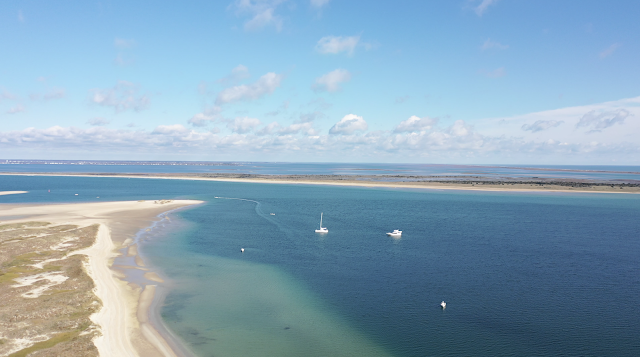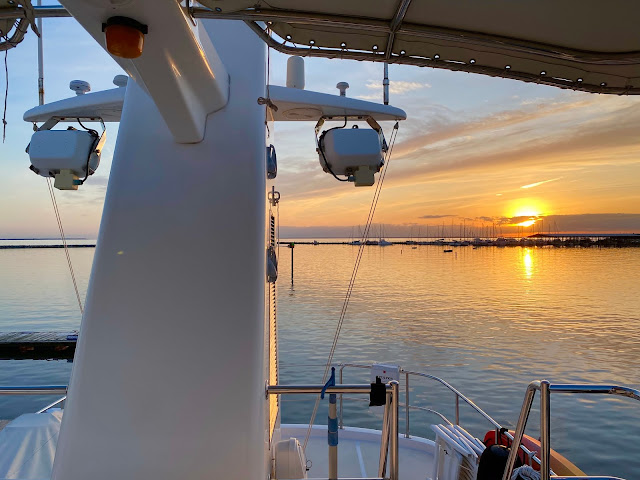Welcome To The Flight Deck!
I interrupt this planned posting about anchoring for an important announcement.
__________
This morning, I successfully, launched, flew, and landed our drone from the front deck of our boat — which I will now call the flight deck (like aircraft carriers do).
Backstory. My dad bought the drone even before he bought the boat. He thought it would add to our experience. Fast forward nearly 1-1/2 years later, he still hadn't flown it.
Why? Well, let’s just say he's known for being “cautious.”
I’ve been asking him to fly the drone for months now but he never seemed to want to do it.
Until the other day at River Dunes. That’s when he told me I should fly it, because kids are better at learning and handling new electronics than adults. (He tried a couple months ago to ride my Hoverboard. He couldn’t even stand on it. I still don't understand why...)
Anyway, so together we watched a few how-to videos on YouTube.
And then, I took my first test flights.
The weather was perfect: no clouds, no wind. There there was plenty of flat space too.
It went great! I was happy to know we had finally started to use the drone.
It felt cool to run the controls. And it was thrilling to see from the sky.
__________
Which brings me to today.
We are currently "on the hook," which is the boater term for anchoring (more about that in my next blog posting). Because we had high winds last night and were forecast to have even higher winds today and tonight, my dad didn’t want to launch our tender and go to shore. He didn’t want to leave our boat unattended, in case the anchor dragged, and he didn’t want to risk our tender sliding off the beach without us. I was not happy about this. I wanted to explore. But my dad said no. He also reminded me that raising the tender back onto our upper deck in high winds with a rocking boat is tricky, and can can cause damage, as the tender can swing pretty wildly in wind gusts and, especially, on the end of a crane attached to the boat.
So I suggested we fly the drone from the boat. We had planned to do that sometime, but this would be the second time I’ve flown it.
From the boat? In climbing winds? And when the useable area of our front deck is only about (4 feet by 6 feet). 😳
My dad suggested I launch and land the drone a few times, just to see if I could do it safely (not our safety... the drone’s). That sounded fine to me. I really wanted to fly. But when I started to practice in the rising and falling winds — lifting off maybe 2 feet and then landing— I found it so stressful. So I said “no way” to a real flight today.
My dad, who is usually the most cautious, encouraged me to do it. But I didn’t feel good about it. So I went back to my book in my room. For the next hour, my dad kept calling out the wind speeds and kept asking me “are you sure, Salter?”
Finally, I changed my mind. But that was after asking him if he’d be mad if I crashed it. He said no.
So in 5 minutes, I was ready to take off.
I launched in winds ranging from 9 to over 17 knots. It was so stressful, but so exciting!
Here's a link to the amazing footage. https://youtu.be/HbOrjxJgKec
You saw I almost stuck the landing, but missed it at the last second. That didn't matter. I got it down. And it wasn't damaged. And I took some amazing video.
I read where pilots say "any landing you can walk away from is a good one."
You probably saw in the video that I didn't capture my take off. I'd forgotten to press "record." So I created a pre-flight checklist to remind me to do that and other things. Just as we have our lists before heading out on the boat.
My list.
For the boat, we have a binder of pre-departure steps including planning, engine room check, power management, main engine start up, and casting off. We also tape this little list right over the engine key, to make sure we don't forget these last steps the next time we power up.
And then there's this. It's taped in front of the helm. It's not a list. But we learned it helps us. For the drone however, there's no "stopping." Especially when we launch from the water. Maybe "If Confused, Hover?"
From 400 feet above sea level, here we see in the background, the famous Shoals of Allyson Rockwell.
You might be interested to know live-aboard boaters don't just use drones for fun or videos. Live-aboards sometimes use drones to scan the area (to see what's beyond whatever cove or anchorage they are in). They also use drones to survey depths, shoals, and channels in unmarked areas, so they have a better idea where to pass or anchor. The birds eye view of the Shoals of Allyson Rockwell is an excellent example of this.
___________
So what did I learn today?
Running the drone:
I learned that to fly and land the drone, I needed to look at the display in front of me, not the drone itself. That way, I could see its position far better, and I could be much more accurate in every part of flying, including landing. My dad tells me that's what instrument certified pilots are taught to do: trust what their instruments are telling them, not their own eyes.
I also learned that I needed to turn off the drone's obstacle avoidance systems (it has crash prevention sensors on all sides as well as below), because these systems would have interfered with me handling the winds and the shifting boat.
I also learned that, since we are on the hook, I couldn’t use the drone's "return to home" safety function. Meaning, I had to do it all myself. This was because it uses GPS to mark its take off position. Yet our boat, moving around in the wind at anchor, would almost certainly not be at that same position when it came time to land.
About how drones move:
I learned that drones (as well as our boat!) share similar words to describe the various ways they move. Pitch is the up and down movement at the front. Roll is the overall side to side movement. Yaw is a twisting movement from side to side. And crabbing, is when the whole thing slides sideways at the same time it's moving forward or backward.
About myself:
I learned it's ok to back away from what I first wanted to do. I learned it's sometimes smart to practice -- to do some testing before I make my decision whether to do something or not. I learned (because I forgot to press "record" and missed my take off video footage) to make a written pre-flight checklist and to follow it. In other words, I learned how to help myself make a good flight. I learned that sometimes it takes time to build the courage to attempt something new, or newer. And I learned how amazing it feels to succeed after doing something hard. The flight today was only 4 minutes. But it made my day.
__________
My dad tells me to leave something extra at the end of my posts. I found an amazing Ted Talk about how drones can be programmed and controlled. It was made in June 2013. That's over 7 years ago. Given how quickly technology is moving, there must be some incredible new drones and things drones can do since then. Here's the Ted:
__________
P.S. We found a company that makes protective "jackets," which allow drones like ours to fly in bad weather, and even land and take off from the water. https://www.phantomrain.org
P.P.S. There are underwater drones. Some are amazing. They are too expensive for us though. And why would we even think of one? Not so much for the sightseeing, but because they would help us inspect damage under the boat without needing to call in a diver. We don't plan to buy one. But I'll bet basic affordable ones are not far away. https://youtu.be/8A2bvbV3Wx4
P.P.P.S. The next step for me is learning to take off, fly, and land the drone while we are underway. That won't be for a while I think, but stay tuned.











Great flying, Salter! I’d say you stuck the landing.
ReplyDeleteKeep practicing and you’ll be a pro before you know it.
You should try out the Mavic’s auto “Trace” & “Spotlight” features.
Finally, the drone has made its debut! I love that you pushed past your fears and took a chance. And look how great the result is! Well done, Salter. The footage is magnificent. This newfound talent should make your blog posts even more spectacular because you can better show the beauty of the coastal Carolinas. On another note: Who knew there are wet suits and rain gear for drones? That seems crazy to me but I'm sure there are good uses for that type of equipment. Keep up the great posts. We are all enjoying them. Love, Mom.
ReplyDeleteLove it! I need to get one of those and you can teach me how to use it. I never new your dad was cautious, :) It's a good thing to be prepared on a boat.
ReplyDelete